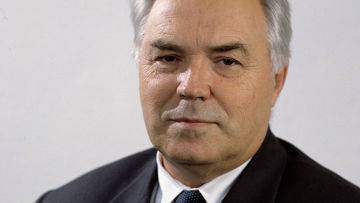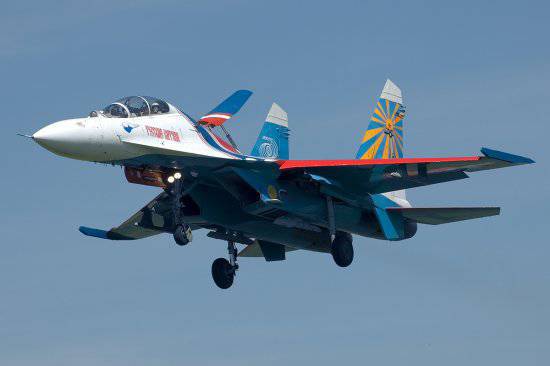Mikhail Simonov: aircraft designer, whose Su-27 is considered the best fighter of the XX century ("The Independent", Great Britain)
 Mikhail Simonov was an aircraft designer whose advanced aircraft brought the Soviet Union into the air war leaders.
Mikhail Simonov was an aircraft designer whose advanced aircraft brought the Soviet Union into the air war leaders. His highly maneuverable Su-27 aircraft with powerful weapons was recognized as the best fighter of the 20th century. He opened the Soviet Union export market the best weapons systems.
Simonov's name has become synonymous with innovative developments and projects. Simonov created a series of Su fighters that envy the West. The aircraft was developed to counter the American F-15. The Simonovsky Su-27 with two engines and two-tail vertical tailing entered service with the USSR Air Force in 1984 and won the respect of the West due to its range, 3200 kilometers, high maneuverability and speed, 2,35 times the speed of sound.
The plane was a star at international air shows, performing such aerobatics that were beyond the power of other fighters. Only MiG aircraft and the AK-47 Kalashnikov assault rifle stood on the same step as the symbol of Russia's significant achievements in the production of weapons. The Su-27's excellent thrust-to-weight ratio and sophisticated control system allow it to perform exceptional maneuvers at very low speeds, for example, to snatch up and stand for a few seconds on the tail. This figure is called "cobra."
However, the rise of the Su-27 to the pinnacle of glory was not smooth. In 1977, his prototype (T-10) was considered worse than the American fighter, which was already in the army. Simonov had to go to the minister aviation industry and explain that the machine needs refinement. He later recalled how the minister told him: “It’s good that today is not 1937.” It was regarded as a scandal. After a series of alterations, accidents and significant problems during the experimental design work of the Su-27 in 1984, it was put into service, although difficulties in production delayed its mass production until 1986.
Simonov believed that the restructuring would allow him to become the best aircraft over time. After the collapse of the Soviet Union in 1991, the shortage of funds forced the Sukhoi company to begin selling aircraft abroad. After a visit to the United Arab Emirates and the wishes that sounded there to get a machine capable of conducting air combat and destroy underwater and ground targets, Su-27 was modernized, turning it into a multi-purpose fighter.
After 1991, when the state defense order was close to zero, Simonov played a major role in obtaining lucrative contracts for the supply of Su-27 to China, India and other foreign customers. He was highly appreciated for keeping Sukhoi company afloat during the period when most other Russian aircraft manufacturers fought for survival.
Su-27 remained the foundation of the Russian Air Force after the collapse of the Soviet Union, along with more modern modifications, such as the Su-30 and Su-35. Simonov's creations gained a reputation for being the best machines in 90s, when Su-27 pilots were invited to participate in training flights in conjunction with F-15 crews.
The rules of the "battle" demanded that Russian aircraft take the tail of American fighters. Then the opponents changed places. In both cases, Su's aircraft gained the upper hand thanks to their high maneuverability and thrust-to-weight ratio. These qualities allowed them to pick up speed on an upward trajectory faster than F-15.
An even more impressive victory was won in 2004, when American F-16 was opposed by Su-30MKI in a training battle. "The defeat was undeniable," said Simonov. In 2006, Su-30MKI participated in training battles with the British "Tornado". Vice-Marshal of the British Air Force Christopher Harper highly appreciated Su-30MKI’s air combat capabilities, calling the aircraft “absolutely masterful and invincible.”
Mikhail Petrovich Simonov was born in 1929 year in the family of teachers in the city of Rostov-on-Don, located in south-west Russia between the Black and the Caspian Sea. He fell in love with aviation during World War II, and in his youth he worked in an aircraft modeling circle. In 1947, Simonov entered the Novocherkassk Polytechnic Institute, which is one of the largest technical universities in Russia. There he studied in the specialty “design and operation” and became a Stalin scholar. In 1951, Simonov transferred to the famous Kazan Aviation Institute, which in 1973 was named after aircraft designer Andrei Tupolev. After graduating from 1954, he remained at the institute, where he became the chief designer. Later, Simonov created a sports aviation club, which became famous with him. There he flew the first Soviet all-metal gliders.
Simonov's abilities did not go unnoticed, and in 1969, he was transferred to Moscow, appointing Deputy Chief Designer of the Taganrog Aviation Company deputy (as in the text - approx. Transl.). A year later, he fell into the Sukhoi Design Bureau - also as deputy chief designer. The next nine years Simonov was responsible for the development of the Su-24 front-line bomber, the Su-25 attack aircraft and the Su-27 fighter.
In the 1979 year, due to disagreements with the head of the Sukhoi Design Bureau, Simonov joined the Ministry of Aviation Industry as a deputy minister for science and new technologies. His task was to create air combat systems. In 1981, Simonov was sent to Afghanistan to provide technical assistance in the operation of the Su-25, which was used in the fight against the Mujahideen rebels. By the end of that war, there were almost 50 Su-25s that had flown 60000 on Afghan air bases. From 1981 to the end of the war in 1989, the 21 aircraft was lost.
More than 25 years Su-25 was used in air battles as part of the Air Force of several countries. Iraq used it in the war with Iran in 1980-1989. Most of the vehicles were later destroyed or exported to Iran during the Gulf War in 1991. In 1993, Abkhaz separatists used this aircraft against Georgians. Eight years later, Macedonia applied Su-25 against Albanian militants. And in the 2008, Georgia and Russia used the Su-25 during the conflict in South Ossetia. This car in the fight against local partisans and in civil wars used and African states such as Cote d'Ivoire, Chad and Sudan.
In January, 1983, Simonov returned to the Sukhoi Design Bureau as the general designer (from 1995 to 1999, he headed the company created on its basis as the general director). Under his leadership, the company gained worldwide fame and high reputation by creating a whole series of multi-purpose aircraft, such as the Su-30, which is designed to gain air superiority, the deck fighter Su-33 and the fighter-bomber Su-34. Simonov also saw the future of aviation in the development of the civil aircraft industry, creating projects and prototypes of passenger aircraft capable of flying at supersonic speeds.
Simonov received a number of state awards and prizes, including the three highest awards that were given in the Soviet Union for scientific achievements. He became the winner of the Lenin Prize, was awarded a gold medal to them. V. G. Shukhov, as well as the Order of the Red Banner of Labor. In 1999, he was awarded the title Hero of the Russian Federation. He is a full member of the Russian Academy of Aviation and Aeronautics and the International and Russian Engineering Academies.
Simonov was buried in the prestigious Novodevichy cemetery in Moscow, where the graves of such famous people as former President Boris Yeltsin and cellist Mstislav Rostropovich, famous throughout the world, are located.
Mikhail Petrovich Simonov, an aircraft designer, was born in 1929 in Rostov-on-Don, died 4 in March 2011 in Moscow.
- Martin Childs
- http://www.independent.co.uk/news/obituari...ry-2240870.html"rel =" nofollow ">http://www.independent.co.uk/news/obituari...ry-2240870.html

Information